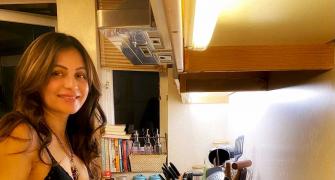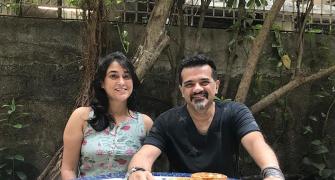Amish Tripathi had a joyful childhood growing up in Kansbahal, a small town in Odisha, where his father worked for L&T.
His earliest memory of his mother's cooking was the simple delicious meals she prepared.
Her buknu masala was exceptional and Amish was a big fan of her kadu ki sabzi.
'Ours was a family of modest means, and Ma had to be careful with the limited money she had at her disposal,' he recalls.
In Sudha Menon's book Recipes For Life, the best-selling author (The Immortals of Meluha, Scion of Ikshvaku, Legend of Suheldev: The King among other novels) recalls the meals he ate growing up.
Scroll down to read an excerpt and to find the unique recipe for an urad dal dumplng broth from Amish's mom, Mrs Usha Tripathi.

Photograph: Kind courtesy Amish Tripathi/Instagram
Sunday lunch was special because of the puris and slightly more luxurious accompaniments like paneer or kaddu ki subzi, which we could not afford daily.
What made the meal more special was that we -- my parents, three siblings and I -- would eat together as a family.
Ma made the best kaddu ki sabzi and puri.
I also loved her khichdi, warm and gooey, which she served with ghee, dahi, papad and a sprinkle of buknu masala. I have never tasted anything as distinctive as buknu masala in any other part of India, and I remember how a mere sprinkle of it would immediately enhance the taste of even the most insipid dish.
The buknu masala was Ma's favourite travel staple and would go on rotis, parathas or whatever food we were carrying along with us.
Ma is from Gwalior in Madhya Pradesh and my father from Varanasi, Uttar Pradesh, but the food we ate at home was largely simple fare from the Purvanchal region of UP, where meals would begin with roti and end with rice.
Our daily meals were largely vegetarian, comprising dal, roti, chawal and subzi. Although my parents enjoyed fish, they preferred to eat it at restaurants.
My strongest memory of Ma and food will always be her golden rule that we had to eat whatever was cooked for the family, because it was 'good' for us. I will never forget how Didi and I got into trouble once, because we pushed away our thalis when we saw karela sabzi on them.
Ma was so furious that she made us eat karela for lunch and dinner for the entire week. I was upset back then, but I understand her better now.
She would say that if we got used to having things our way right from childhood, we would not be able to handle life's ups and downs when we grew up.
'Learn to make do with whatever you have,' she would say. I am glad we got those lessons early on, because now I am able to handle tough situations when they come.
Here's a hearty, earthy but flavoursome recipe of Panyucha that uses urad dal from Amish's mother Usha Tripathi. It is usually served to baraatis during weddings.
On a weekday, save yourself the trouble of cooking an elaborate meal and make this easy recipe that can be relished with steamed rice and fried papad.
Panyucha
Serves: 2
Ingredients
- 1 cup or a small bowl or about 300 gm white urad dal, or skinless black gram, washed, soaked for around two hours
- 1-inch piece ginger
- 2 long or cloves
- 2 pieces badi elaichi or black cardamom
- 2 pieces chhoti elaichi or green cardamom
- 3-5 black peppercorns
- Small piece of dalchini or cinnamon
- 1 tej patta or bay leaf
- Pinch of haldi or turmeric
- Pinch of red chilly powder
- Pinch of dhania or coriander powder
- Pinch of garam masala
- Salt to taste
- 3 tsp mustard oil or ghee
- 2 l water + 2 tbsp extra
Method
- Grind the soaked urad dal to a fine paste with salt and ginger.
Transfer the urad dal mixture onto a cloth.
Hold the edges together and tie it tightly into a potli. Set aside. - In a large saucepan, boil about 2 litres of water.
When the water starts boiling, add the urad dal potli.
Let the water continue to boil till the urad dal potli rises to the top and begins to float,about 15-20 minutes.
The urad dal will be hard to touch.
Take off heat and let the urad dal potli stay in the water.
Take a few tbsp water in a bowl and to this add red chilly powder, haldi, coriander powder and garam masala.
Mix it well until it is a smooth paste with no lumps. - In a large saucepan heat the mustard oil or ghee.
Add the whole spices.
When the spices stop spluttering, add the paste of the powdered spices.
Mix well.
Add an adequate quantity of water from the urad dal saucepan into the seasoning.
Boil.
Remove the urad dal cake from the potli and cut it into barfi-shaped pieces.
Add to the boiling water.
When ready, the Panyucha will have slightly thickish consistency like the gravy of aloo tamatar sabji.
Take off heat and serve with steaming hot rice and papad.
Note: Yellow mung dal may be used instead of white urad dal and you might consider adding a little masala to the urad or mung paste like jeera powder and/or black pepper powder.
Swap the ginger for Jain-friendly ginger powder for a Jain version of Panyucha.
Excerpted from Recipes For Life by Sudha Menon with kind permission from the publishers Penguin Random House India.










